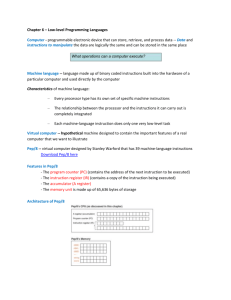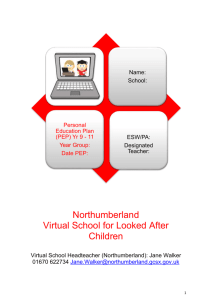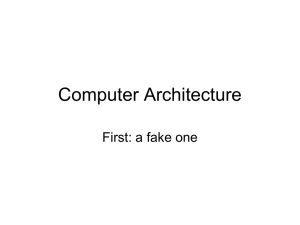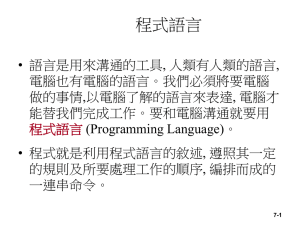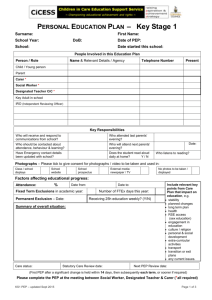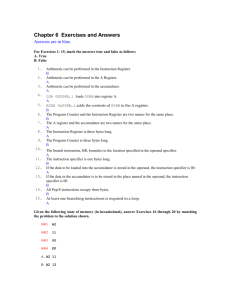Chapter 7: Low-Level Programming Languages
advertisement
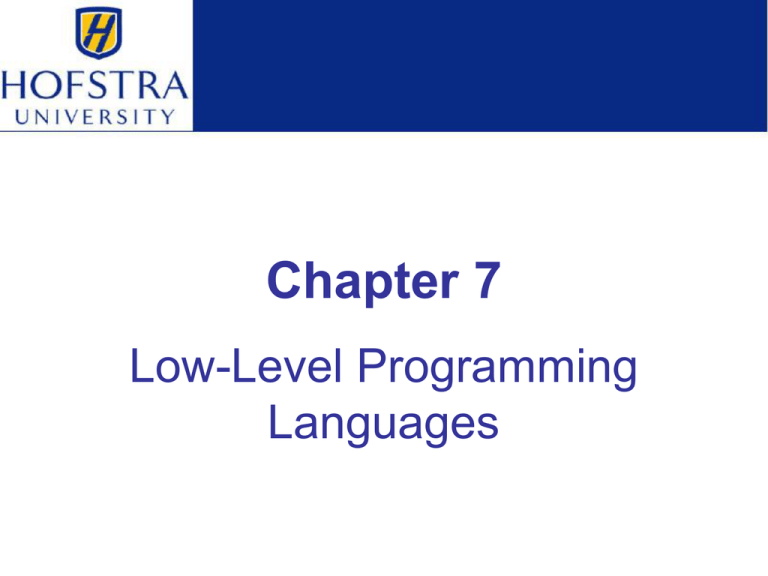
Chapter 7 Low-Level Programming Languages Chapter Goals • List the operations that a computer can perform • Discuss the relationship between levels of abstraction and the determination of concrete algorithm steps • Describe the important features of the Pep/7 virtual machine • Distinguish between immediate mode addressing and direct addressing 7-2 Chapter Goals • Convert a simple algorithm into a machinelanguage program • Distinguish between machine language and assembly language • Describe the steps in creating and running an assembly-language program • Convert a simple algorithm into an assemblylanguage program 7-3 Chapter Goals • Distinguish between instructions to the assembler and instructions to be translated • Describe two approaches to testing • Design and implement a test plan for a simple assembly-language program 7-4 Computer Operations • A computer is a programmable electronic device that can store, retrieve, and process data • Data and instructions to manipulate the data are logically the same and can be stored in the same place • Store, retrieve, and process are actions that the computer can perform on data 7-5 Machine Language • Machine language The instructions built into the hardware of a particular computer • Initially, humans had no choice but to write programs in machine language because other programming languages had not yet been invented 7-6 Machine Language • Every processor type has its own set of specific machine instructions • The relationship between the processor and the instructions it can carry out is completely integrated • Each machine-language instruction does only one very low-level task 7-7 Pep/7: A Virtual Computer • Virtual computer A hypothetical machine designed to contain the important features of real computers that we want to illustrate • Pep/7 – designed by Stanley Warford – has 32 machine-language instructions • We are only going to examine a few of these instructions 7-8 Features in Pep/7 • The memory unit is made up of 4,096 bytes • Pep/7 Registers/Status Bits Covered – The program counter (PC) (contains the address of the next instruction to be executed) – The instruction register (IR) (contains a copy of the instruction being executed) – The accumulator (A register) – Status bit N (1 if A register is negative; 0 otherwise) – Status bit Z (1 if the A register is 0; and 0 otherwise) 7-9 Features in Pep/7 Figure 7.1 Pep/7’s architecture 7-10 Instruction Format • There are two parts to an instruction – The 8-bit instruction specifier – And optionally, the 16-bit operand specifier Figure 7.2 The Pep/7 instruction format 7-11 Instruction Format • The instruction specifier is made up of several sections – The operation code – The register specifier – The addressing-mode specifier 7-12 Instruction Format • The operation code specifies which instruction is to be carried out • The 1-bit register specifier is 0 if register A (the accumulator) is involved, which is the case in this chapter. • The 2-bit addressing-mode specifier says how to interpret the operand part of the instruction 7-13 Instruction Format Figure 7.3 Difference between immediate-mode and direct-mode addressing 7-14 Some Sample Instructions Figure 7.3 Subset of Pep/7 instructions 7-15 A Program Example • Let’s write "Hello" on the screen Page 200 7-16 Pep/7 Simulator • A program that behaves just like the Pep/7 virtual machine behaves • To run a program, we enter the hexadecimal code, byte by byte with blanks between each Page 202 7-17 Assembly Language • Assembly languages A language that uses mnemonic codes to represent machine-language instructions – The programmer uses these alphanumeric codes in place of binary digits – A program called an assembler reads each of the instructions in mnemonic form and translates it into the machine-language equivalent 7-18 Pep/7 Assembly Language 7-19 Assembly Process 7-20 A New Program Page 213 7-21 Our Completed Program Page 214 7-22 Status Bits Status bits allow a program to make a choice. BRLT Set the PC to the operand, if N is 1 (A register is less than zero) BREQ Set the PC to operand, if Z is 1 (A register is equal to zero) 7-23 Testing • Test plan A document that specifies how many times and with what data the program must be run in order to thoroughly test the program • A code-coverage approach designs test cases to ensure that each statement in the program is executed. • A data-coverage approach designs test cases to ensure that the limits of the allowable data are covered. 7-24
